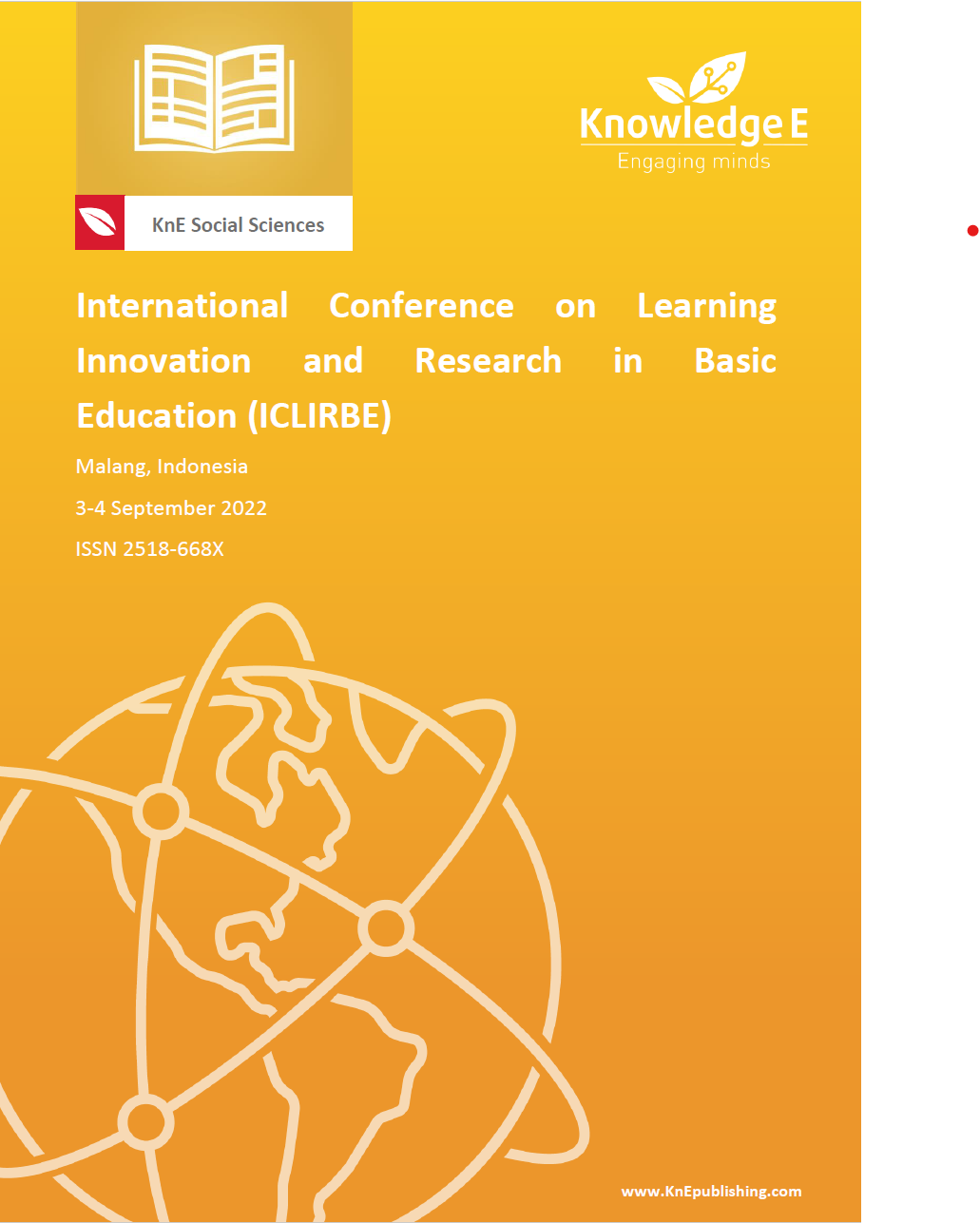Analysis of the Integrity of Prospective Teachers
DOI:
https://doi.org/10.18502/kss.v8i8.13285Abstract
Integrity is an essential character requirement for becoming a civics teacher. One can be known through his work for finding reliable prospective teachers. Every prospective civics teacher in junior and senior high school must complete the final lecture while attending lectures. The final project must be the work of the future teacher who meets the plagiarism assessment with a certain percentage (maximum 30%). Through a qualitative study of 79 prospective civics teachers in junior and senior high schools in the Quantitative Research course, it aims to answer the problem of plagiarism assessment as an indicator of the integrity of the prospective teacher. Researchers used qualitative analysis to analyze all data acquisition. The results showed that 54 (68.4%) future teachers had more than 30% similar abilities, and 25 people (31.6%) had less than 25% similarity. All prospective teachers responded positively to using the plagiarism assessment as a medium for detecting integrity. Through such tests, they are motivated to study more carefully and earnestly to make themselves worthy of being prospective civics teachers who meet the integrity requirements.
Keywords: integrity, plagiarism, final project, prospective teachers
References
[2] Adebayo FA. “Stakeholders perception of teachers integrity in elementary schools in Nigeria.” Lit Inf Comput Educ J (LICEJ). 2013;4(4):1214–1219.
[3] Mason M. “The ethics of integrity: Educational values beyond postmodern ethics.” J Philos Educ. 2001;35(1):47–69.
[4] Detrich R. “Treatment integrity: Fundamental to education reform.” J Cogn Educ Psychol. 2014;13(2):258–271. doi: 10.1891/1945-8959.13.2.258.
[5] Musschenga AW. “Education for moral integrity.” J Philos Educ. 2001;35(2):219–235.
[6] Suud FM, Sutrisno, Abd. Madjid. “Educational honesty: The main philosophical value in school.” TARBIYA: J Educ Muslim Soc. 2019 Dec;6(2):141–154. doi: 10.15408/tjems.v6i2.11769.
[7] Bruce M, Zhang J, Pun A. “Academic integrity: A review of the literature.” Stud High Educ. 2014 Feb;39(2):339–358. doi: 10.1080/03075079.2012.709495.
[8] McKenney ELW, Waldron N, Conroy M. “The effects of training and performance feedback during behavioral consultation on general education middle school teachers’ integrity to functional analysis procedures.” J Educ Psychol Consult. 2013 Jan;23(1):63–85. doi: 10.1080/10474412.2013.757152.
[9] Martinez-Maldonado R, Mangaroska K, Schulte J, Elliott D, Axisa C, Shum SB. “Teacher tracking with integrity: What indoor positioning can reveal about instructional proxemics.” Proc ACM Interact Mob Wearable Ubiquitous Technol. 2020 Mar;4(1). doi: 10.1145/3381017.
[10] Chang Y-S, Chou CH, Chuang MJ, Li W-H, Tsai I-F. “Effects of virtual reality on creative design performance and creative experiential learning.” Interactive Learning Environments; 2020. p. 1–16. doi: 10.1080/10494820.2020.1821717.
[11] Wahyudi, Verawati NNSP, Ayub S, Prayogi S. “Development of inquiry-creativeprocess learning model to promote critical thinking ability of physics prospective teachers.” J Phys: Conf Ser. 2018 Dec;1108(1). doi: 10.1088/1742-6596/1108/1/012005.
[12] Ilmi Z, Darma DC, Azis M. “Independence in learning, education management, and industry 4.0: Habitat Indonesia during COVID-19.” J Anthr Sport Phys Educ. 2020;4(4):63–66. doi: 10.26773/jaspe.201010.
[13] Jereb E, Perc M, Lämmlein B, Jerebic J, Urh M, Podbregar I, et al. “Factors influencing plagiarism in higher education: A comparison of German and Slovene students.” PLoS One. 2018 Aug;13(8):e0202252. doi: 10.1371/journal.pone.0202252.
[14] Gasparyan AY, Nurmashev B, Seksenbayev B, Trukhachev VI, Kostyukova EI, Kitas GD. “Plagiarism in the context of education and evolving detection strategies.” J Korean Med Sci. 2017 Aug;32(8):1220–1227. doi: 10.3346/jkms.2017.32.8.1220.
[15] Bretag T. “Challenges in addressing plagiarism in education.” PLoS Med. 2013;10(12):1–4. doi: 10.1371/journal.pmed.1001574.
[16] Do Ba K, Do Ba K, Lam QD, Le DTBA, Nguyen PL, Ngyuen PQ, et al. “Student plagiarism in higher education in Vietnam: An empirical study.” High Educ Res Dev. 2017 Jul;36(5):934–946. doi: 10.1080/07294360.2016.1263829.
[17] Gullifer JM, Tyson GA. “Who has read the policy on plagiarism? Unpacking students’ understanding of plagiarism.” Stud High Educ. 2014;39(7):1202–1218. doi: 10.1080/03075079.2013.777412.
[18] Šprajc P, Urh M, Jerebic J, Trivan D, Jereb E. “Reasons for plagiarism in higher education.” Organizacija. 2017 Feb;50(1):33–45. doi: 10.1515/orga-2017-0002.
[19] Fauziah M, Marmoah S, Murwaningsih T, Saddhono K. “The effect of thinking actively in a social context and creative problem-solving learning models on divergentthinking skills viewed from adversity quotient.” Eur J Educ Res (Eurasian Society of Educational Research). 2020 Apr 01;9(2):537-568. doi: 10.12973/eu-jer.9.2.537.
[20] DiGennaro FD, Martens BK, Kleinmann AE. “A comparison of performance feedback procedures on teachers’ treatment implementation integrity and students’ inappropriate behavior in special education classrooms.” J Appl Behav Anal. 2007 Sep;40(3):447–461. doi: 10.1901/jaba.2007.40-447.
[21] Montoneri B. “An analysis of creative process learning in computer game activities through player experiences Wilawan Inchamnan.” IAFOR J Educ. 2016;4(2):119–139.
[22] Rachul C, Collins B, Ahmed M, Cai G. “Twelve tips for designing assignments that foster independence in learning.” Med Teach. 2021;43(1):75–79. doi: 10.1080/0142159X.2020.1752914.
[23] Ananda R. “The effect of learning strategies and learning independence on learning outcomes in learning evaluation subject.” IJLRES-Int J Lang Res Educ Stud. 2019;3(3):340–350. doi: 10.30575/2017/IJLRES-2019091201.
[24] Risparyanto A. “Turnitin Sebagai Alat Deteksi Plagiarisme.” UNILIB : Jurnal Perpustakaan. 2020 Aug 2;11(2). doi: 10.20885/unilib.vol11.iss2.art5.
[25] Dillak RY, Laumal F, Kadja LJ. “Sistem Deteksi Dini Plagiarisme Tugas Akhir Mahasiswa menggunakan Algoritma N-Grams dan Winnowing.” Jurnal Ilmiah FLASH. 2016;2(1):12–18.
[26] Filcha A, Hayaty M. “Rabin-Karp algorithm implementation to detect plagiarism on student’s assignment document.” JUITA. 2019;VII(1):25–32.
[27] Boehm PJ, Justice M, Weeks S. “Promoting academic integrity in higher education introduction and review of literature.” The Community College Enterprise, vol. Spring; 2009. p. 45–61.
[28] Menzel DC. “Research on ethics and integrity in public administration: Moving forward, looking back.” Public Integr. 2015 Oct;17(4):343–370. doi: 10.1080/10999922.2015.1060824.
[29] Paredes SG, Peña FdeJJ, Alcazar JMdeLF. “Remote proctored exams: Integrity assurance in online education?.” Distance Education. 2021;42(2):200–218. doi: 10.1080/01587919.2021.1910495.
[30] Rosen Y, Stoeffler K, Simmering V. “Imagine: Design for creative thinking, learning, and assessment in schools.” J Intell. 2020 Jun;8(2). doi: 10.3390/jintelligence8020016.
[31] Thomas PL. “A new honesty in education-positivist measures in a post-modern world.” Contemp Educ. 1999;71:51–67.
[32] Pensar J, Nyman H, Lintusaari J, Corander J. “The role of local partial independence in learning of Bayesian networks.” Int J Approx Reason. 2016 Feb;69:91–105. doi: 10.1016/j.ijar.2015.11.008.

